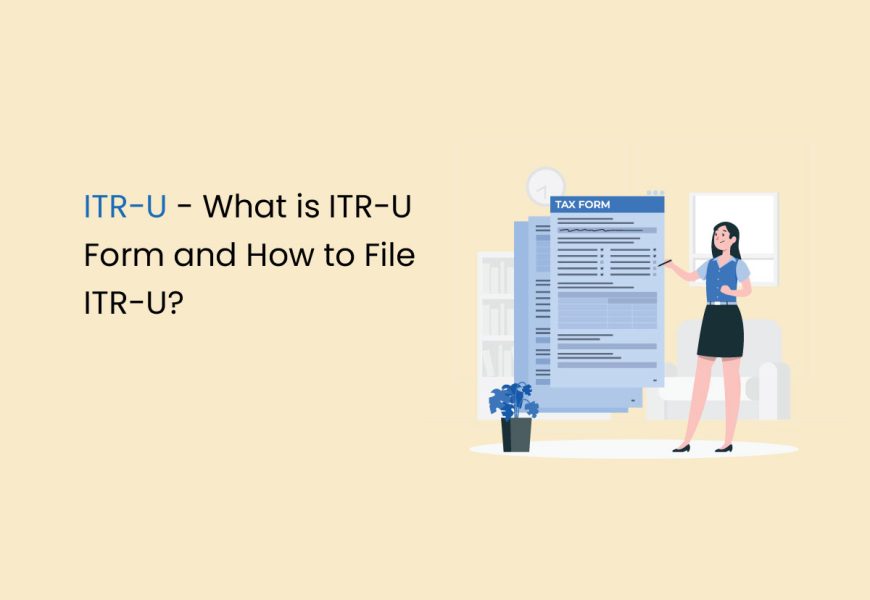The ITR-U form serves as a pivotal tool for individuals seeking to amend their income tax returns by addressing inaccuracies or omissions within a permissible timeframe of up to two years from the conclusion of the relevant assessment year. The government officially introduced the incorporation of updated returns in the Union Budget of 2022, marking a noteworthy enhancement in the tax filing process.
Read on to take a deeper dive into the nuances of the ITR-U form in our upcoming article, where we shed light on its significance and guide you through the intricacies of rectifying errors to ensure a seamless tax filing experience.
What is ITR U?
Have you ever found yourself in a situation where you either forgot to report certain income or made inadvertent mistakes in your Income Tax Return (ITR)? This is where Section 139(8A) of the Income Tax Act offers you a valuable opportunity to rectify such oversights within a window of two years. This period is calculated from the conclusion of the year in which the initial return was filed.
Enter ITR-U, a solution introduced to streamline tax compliance without triggering legal repercussions. According to Income Tax laws, the deadline to file ITR under Section 139(1) for the financial year 2021-22 (Assessment Year 2022-23) was set for 31 July 2022. Subsequently, a belated return could be submitted until 31 December 2022 for those who missed the original deadline. This extension also allowed for the submission of revised returns, enabling individuals to rectify errors or omissions made in their initial ITR filings.
The government, in its Union Budget for 2022, introduced the ITR U form, designed specifically for updating income tax returns. Serving as a lifeline for those who failed to file their ITRs or inadvertently entered inaccurate information, the ITR-U form is a key component in optimising the tax compliance process.
ITR-U allows taxpayers to amend errors or omissions in their ITRs within a two-year timeframe from the conclusion of the relevant assessment year. For example, for the assessment year 2021-22, an updated return can be submitted by 31 March 2024 for individuals who overlooked reporting certain income.
This holds true regardless of whether the taxpayer filed an original, belated, or revised ITR, or even if they missed filing the ITR altogether in a specific financial year. Stay informed as we delve deeper into the intricacies of ITR-U and guide you through the process of updating your income tax returns effectively.
What is Section 139(8A)?
Section 139(8A) of the Income Tax Act provides individuals with an opportunity to amend or update their Income Tax Returns (ITR) within a timeframe of two years, specifically within 24 months from the conclusion of the relevant assessment year. This provision, under Section 139(8A), enables taxpayers to rectify any errors or incorporate necessary updates in their original return without being subjected to legal consequences for providing inaccurate information.
Who is Eligible to File ITR-U?
ITR-U, or an Updated Return, can be filed by individuals who have identified errors or omissions in any of the following types of returns:
- Original return of income,
- Belated return, or
- Revised return.
An Updated Return is applicable in the following scenarios:
- Failure to file the return within the deadline or the belated return deadline.
- Incorrect declaration of income.
- Selection of the wrong head of income.
- Incorrect tax rate payment.
- Adjustment of carried forward loss.
- Adjustment of unabsorbed depreciation.
- Adjustment of tax credit under sections 115JB/115JC.
It’s important to note that a taxpayer can file only one updated return for each assessment year (AY).
Who is Ineligible to File ITR-U?
ITR-U cannot be filed under the following circumstances:
- An updated return has already been filed.
- Filing a nil return or a loss return.
- Seeking to claim or enhance the refund amount.
- When the updated return results in a lower tax liability.
- If a search proceeding under section 132 has been initiated against you.
- Conduct of a survey under section 133A.
- Seizure or requisition of books, documents, or assets by Income Tax authorities under section 132A.
- Pending or completed assessment, reassessment, revision, or recomputation.
- When there is no additional tax liability (if the tax liability is adjusted with TDS credit/losses and there is no additional tax liability, an Updated ITR cannot be filed).
What is the Deadline for Filing ITR U?
The time limit for filing an updated return under Section 139 (8A) is 24 months from the conclusion of the relevant assessment year. Here is a breakdown of the last dates for filing updated ITRs:
| Assessment Year | Last Date of Updated ITR Filing |
|---|---|
| AY (2020-21) | 31 March 2023 |
| AY (2021-22) | 31 March 2024 |
| AY (2022-23) | 31 March 2025 |
How to File Form ITR-U?
Form ITR-U requires taxpayers to provide additional details when filing an updated return. Here is a breakdown of the key sections in ITR-U:
Part A – General Information (ITR-U)
- Enter your Permanent Account Number (PAN).
- Provide your Aadhaar Number.
- Mention the Assessment Year for which the return is being filed.
- Indicate whether the return was previously filed for this assessment year. If yes, provide details of the previous filing, including the form filed, Acknowledgement/Receipt No., and Date of filing.
- Confirm your eligibility for filing an updated return.
- Specify the reasons for updating income, such as returns not previously filed, incorrect income reporting, etc.
- Specify whether the updated return is filed within 12 months or between 12 to 24 months from the end of the relevant Assessment Year.
- Specify if the updated return is filed to reduce carried forward loss, unabsorbed depreciation, or claim tax credit.
Part B – Computation of Updated Income and Tax Payable (ITR-U)
- Indicate the head of income under which additional income is being reported.
- Compare the total income as per the last valid return and as per Part B-TI of the updated return.
- Calculate the amount payable or refundable based on the updated income.
- Provide details of tax paid under section 140B and any payments of Advance Tax, Self-Assessment Tax, or Regular Assessment Tax not claimed in the earlier return.
- Determine the additional income-tax liability on the updated income.
- Calculate the net amount payable or refundable.
- Specify details of tax due and tax credits under sections 140B(2) and 89.
Note: Be mindful of the instructions and guidelines provided while filling out each section of the form.
FAQs on ITR U
Is there any penalty for ITR-U?
No penalty is incurred for filing ITR-U. However, an additional tax under section 140B may apply, ranging from 25% to 50% of the tax and interest due, depending on whether the ITR-U is filed within 12 or 24 months from the end of the relevant assessment year.
Can a nil return be filed in ITR-U?
No, filing a Nil return in ITR-U is not possible. ITR-U is intended for situations involving additional tax outflow.
What are the benefits of filing Form ITR-U?
There are multiple benefits to filing Form ITR U:
- Extended Filing Window: Taxpayers enjoy an additional 24 months beyond the original, belated, or revised ITR filing deadlines to submit their Income Tax Returns.
- Reporting Missed Income: Filing an Updated Return allows taxpayers to disclose any overlooked income, enabling them to fulfil their tax obligations and reducing the likelihood of future tax notices and legal disputes.
- Reduced Tax Liability and Penalties: The tax liability and penalties associated with an Updated Return are typically lower than those incurred in proceedings related to undisclosed income or income escaping assessment.
Can I file ITR-U if I missed the original due date?
Yes, ITR-U can be filed even if the original deadline is missed. However, late filing fees under u/s 234F and additional liability of 25% or 50% on the tax payable will apply.
Can a refund be claimed in ITR-U?
No, ITR-U cannot be used to claim a refund, increase the refund amount, file a nil return, or submit a loss return.
Can I exhaust my balance Tax Payment Challans and claim them under ITR-U?
No, pending Advance Tax or Self-Assessment Tax challans should be reported under u/s 140B(2), and credit will not be provided.
Can I claim an extra carry-forward loss under ITR-U?
No, according to section 139(8A), you cannot increase your carryforward loss; you can only reduce the existing balance.
Can I file ITR-U if I have no tax payable?
No, if your total tax is offset with TDS credits, and there is no additional tax liability, filing an updated return is not possible.
Can I file ITR-U if my income is below 5 lakhs and I claimed rebate u/s 87A?
Yes, you can file the updated return, but you'll be liable for late filing fees. Payment details must be updated under the "Taxes Paid under 140B" tab.
Can I change the ITR form number when filing an ITR-U or updated return?
Yes, if the original ITR was filed as ITR-1, and the updated return shifts to ITR 2/3/4 due to additional income sources, such a change will be accepted.
What is the due date for AY 2023-24?
The due date for filing an Updated Return in Form ITR-U for the Assessment Year 2023-24 is 31st March 2026. Taxpayers have until this date, which is 24 months from the end of the relevant Assessment Year (31st March 2024), to submit their Updated Return.





















